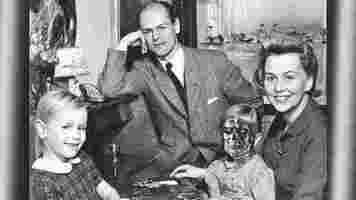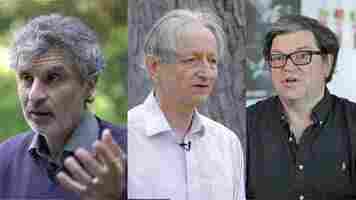Physicists suggest there’s an ‘anti-universe’ behind ours
A team of scientists from University of Waterloo have come up with an exciting new theory that explains the origin of the universe, its expansion, and the presence of dark matter. It involves the existence of a mirrored doppelganger called an ‘anti-universe’ where time runs backwards. And it might even be testable.

The big idea: What if the universe were a physical object? Current thinking says the Big Bang exploded the universe into existence and it’s been expanding ever since.
But the Waterloo team’s work imagines the universe as a space in which the Big Bang occurred. It disputes the long-held scientific notion that the Big Bang was immediately followed by a period of rapid inflation.
If instead, our universe were paired with an anti-universe, a period of rapid inflation wouldn’t have been required after the Big Bang, as particles would have formed naturally over time.
This would allow the entire universe to follow a concept known as CPT symmetry, something that’s normally only applied to particles and their interactions.
As LiveScience’s Paul Sutter recently wrote :
Sutter, an astrophysicist, goes on to explain that this particular theory imagines the universe as a physical object that obeys CPT symmetry.
This means you could flip the universe’s charge, mirror it, and run it backwards, and it should still act the same way it does in its current state.
Here’s where things get fun: In order to support this idea, there’d have to be an anti-universe that meets those three fundamental qualifications.
From what the research appears to indicate, it’d be a backwards-running reverse universe that, essentially, exploded in the opposite direction from ours when the Big Bang occurred.
According to the researchers, the doppelganger anti-universe would potentially have neutrinos in it that were the CPT-symmetric opposite of our universe’s.
The reason that’s important is because the presence of “right-handed” neutrinos would offer up a tidy explanation for dark matter (all of the neutrinos in our universe are referred to as “left-handed” because of the direction of their spin).
Neural’s interpretation: This is super cool.
Imagine our universe as a soap bubble. Now imagine there’s a photo-negative soap bubble connected to the one we live in.
Maybe the Big Bang was just compressed “everything” that gently released all the matter and antimatter into both of those bubbles without popping either. In the anti-universe — the bubble our universe is attached to — time runs backwards and particles expand in the opposite direction. The significance here is that the particles move towards the edges, but neither universe inflates.
The most interesting thing about this whole theory is that we may be able to actually test it one day. The scientists ran “numerous simulations” to confirm many of the assertions in their theory. But the ultimate indicator of whether the universe itself maintains CPT symmetry may come from further study at the edges of quantum astrophysics .
Obviously, humans can’t just zoom out beyond the boundaries of our universe to see if there’s something behind it. But, if it turns out that right-handed neutrinos exist, and we can solve the mystery of dark matter in our own universe, we may be able to demonstrate empirical evidence for the anti-universe’s existence.
Wacky AI paper says we should merge with machines to teach them our ways
You know you’re in for a treat when a pre-print AI research paper begins by explaining that nobody really knows what AI is and ends by solving artificial general intelligence (AGI).

The paper’s called “ Co-evolutionary hybrid intelligence ,” and it’s a work of art that belongs in a museum. But, since it’s state-sponsored research from Russia that was uploaded to a pre-print server, we’ll just talk about it here.
The research is only four pages long, but the team manages to pack a lot in that space. They don’t beat around the bush. You want to know how to solve AGI? Boom! Page one:
The “hybridization of artificial and human capabilities and their co-directional evolution” sounds a lot like people and computers getting the urge to merge and making a go of things together. That’s kind of romantic.
But what’s it really mean? When AI researchers talk about “strong” AI they don’t mean a robot that can carry heavy objects. They’re talking about the opposite of a “narrow AI.”
All modern AI is narrow. We train AI to do a specific (hence narrow) function and then find ways to apply it to a task.
A “strong” AI would be capable of doing anything a person can do. If such an AI ran up against a task it wasn’t trained for, it could write new algorithms or apply knowledge from a similar but unrelated task to solve the problem at hand.
What the researchers propose is a method by which we would stop relying on massive quantities of data to brute-force progress in AI. They say we should combine our natural intelligence with the machines’ artificial intelligence and become permanently linked in a co-evolutionary paradigm.
Per the paper:
As to why this “new frontier” is the only path forward, the researchers offer the following explanation:
The team is telling us that humans can’t build an AI that’s smarter than a human because we’re only human. And, even if we did, we wouldn’t be smart enough understand it.
That sounds pretty deep, if we’re speaking philosophically, but we use math to describe the unknown in physics all the time. It’s difficult to place any scientific value on the assertion we couldn’t define a superintelligent AI if we built one.
Let’s just roll with it though. According to the researchers, the path towards hybrid strong intelligence involves augmenting data-centric training methods with direct human-involvement at every level of learning.
That sounds a lot like the way we “train” humans. We send them to school, they get educated, they become experts, they teach, and the cycle begins anew.
We’re all for such a paradigm. If every AI company had to do hands-on training instead of just smashing everything inside of a black box and monetizing whatever comes out the other end, we wouldn’t be living in a world where AI scams regularly become billion-dollar industries .
It’s hard to imagine how putting more humans in the loop will directly lead to strong AI however.
But, if the researchers are correct in their (somewhat pessimistic and weird) assertion that humans will never create a machine that’s independently smarter than us, a hybrid intellect may be the only way to make people and machines smarter.
You can read the whole paper here .
Pioneers of deep learning think its future is gonna be lit
Deep neural networks will move past their shortcomings without help from symbolic artificial intelligence , three pioneers of deep learning argue in a paper published in the July issue of the Communications of the ACM journal.

In their paper, Yoshua Bengio, Geoffrey Hinton, and Yann LeCun, recipients of the 2018 Turing Award, explain the current challenges of deep learning and how it differs from learning in humans and animals. They also explore recent advances in the field that might provide blueprints for the future directions for research in deep learning.
Titled “ Deep Learning for AI ,” the paper envisions a future in which deep learning models can learn with little or no help from humans, are flexible to changes in their environment, and can solve a wide range of reflexive and cognitive problems.
The challenges of deep learning
Deep learning is often compared to the brains of humans and animals. However, the past years have proven that artificial neural networks, the main component used in deep learning models, lack the efficiency, flexibility, and versatility of their biological counterparts.
In their paper, Bengio, Hinton, and LeCun acknowledge these shortcomings. “Supervised learning, while successful in a wide variety of tasks, typically requires a large amount of human-labeled data. Similarly, when reinforcement learning is based only on rewards, it requires a very large number of interactions,” they write.
Supervised learning is a popular subset of machine learning algorithms, in which a model is presented with labeled examples, such as a list of images and their corresponding content. The model is trained to find recurring patterns in examples that have similar labels. It then uses the learned patterns to associate new examples with the right labels. Supervised learning is especially useful for problems where labeled examples are abundantly available.
Reinforcement learning is another branch of machine learning, in which an “agent” learns to maximize “rewards” in an environment. An environment can be as simple as a tic-tac-toe board in which an AI player is rewarded for lining up three Xs or Os, or as complex as an urban setting in which a self-driving car is rewarded for avoiding collisions, obeying traffic rules, and reaching its destination. The agent starts by taking random actions. As it receives feedback from its environment, it finds sequences of actions that provide better rewards.
In both cases, as the scientists acknowledge, machine learning models require huge labor. Labeled datasets are hard to come by, especially in specialized fields that don’t have public, open-source datasets, which means they need the hard and expensive labor of human annotators. And complicated reinforcement learning models require massive computational resources to run a vast number of training episodes, which makes them available to a few, very wealthy AI labs and tech companies .
Bengio, Hinton, and LeCun also acknowledge that current deep learning systems are still limited in the scope of problems they can solve . They perform well on specialized tasks but “are often brittle outside of the narrow domain they have been trained on.” Often, slight changes such as a few modified pixels in an image or a very slight alteration of rules in the environment can cause deep learning systems to go astray.
The brittleness of deep learning systems is largely due to machine learning models being based on the “independent and identically distributed” (i.i.d.) assumption, which supposes that real-world data has the same distribution as the training data. i.i.d also assumes that observations do not affect each other (e.g., coin or die tosses are independent of each other).
“From the early days, theoreticians of machine learning have focused on the iid assumption… Unfortunately, this is not a realistic assumption in the real world,” the scientists write.
Real-world settings are constantly changing due to different factors, many of which are virtually impossible to represent without causal models . Intelligent agents must constantly observe and learn from their environment and other agents, and they must adapt their behavior to changes.
“[T]he performance of today’s best AI systems tends to take a hit when they go from the lab to the field,” the scientists write.
The i.i.d. assumption becomes even more fragile when applied to fields such as computer vision and natural language processing, where the agent must deal with high-entropy environments. Currently, many researchers and companies try to overcome the limits of deep learning by training neural networks on more data , hoping that larger datasets will cover a wider distribution and reduce the chances of failure in the real world.
Deep learning vs hybrid AI
The ultimate goal of AI scientists is to replicate the kind of general intelligence humans have. And we know that humans don’t suffer from the problems of current deep learning systems.
“Humans and animals seem to be able to learn massive amounts of background knowledge about the world, largely by observation, in a task-independent manner,” Bengio, Hinton, and LeCun write in their paper. “This knowledge underpins common sense and allows humans to learn complex tasks, such as driving, with just a few hours of practice.”
Elsewhere in the paper, the scientists note, “[H]umans can generalize in a way that is different and more powerful than ordinary iid generalization: we can correctly interpret novel combinations of existing concepts, even if those combinations are extremely unlikely under our training distribution, so long as they respect high-level syntactic and semantic patterns we have already learned.”
Scientists provide various solutions to close the gap between AI and human intelligence. One approach that has been widely discussed in the past few years is hybrid artificial intelligence that combines neural networks with classical symbolic systems. Symbol manipulation is a very important part of humans’ ability to reason about the world. It is also one of the great challenges of deep learning systems.
Bengio, Hinton, and LeCun do not believe in mixing neural networks and symbolic AI. In a video that accompanies the ACM paper, Bengio says, “There are some who believe that there are problems that neural networks just cannot resolve and that we have to resort to the classical AI, symbolic approach. But our work suggests otherwise.”
The deep learning pioneers believe that better neural network architectures will eventually lead to all aspects of human and animal intelligence, including symbol manipulation, reasoning, causal inference, and common sense.
Promising advances in deep learning
In their paper, Bengio, Hinton, and LeCun highlight recent advances in deep learning that have helped make progress in some of the fields where deep learning struggles.
One example is the Transformer , a neural network architecture that has been at the heart of language models such as OpenAI’s GPT-3 and Google’s Meena . One of the benefits of Transformers is their capability to learn without the need for labeled data. Transformers can develop representations through unsupervised learning, and then they can apply those representations to fill in the blanks on incomplete sentences or generate coherent text after receiving a prompt.
More recently, researchers have shown that Transformers can be applied to computer vision tasks as well. When combined with convolutional neural networks , transformers can predict the content of masked regions.
A more promising technique is contrastive learning , which tries to find vector representations of missing regions instead of predicting exact pixel values. This is an intriguing approach and seems to be much closer to what the human mind does. When we see an image such as the one below, we might not be able to visualize a photo-realistic depiction of the missing parts, but our mind can come up with a high-level representation of what might go in those masked regions (e.g., doors, windows, etc.). (My own observation: This can tie in well with other research in the field aiming to align vector representations in neural networks with real-world concepts.)
The push for making neural networks less reliant on human-labeled data fits in the discussion of self-supervised learning , a concept that LeCun is working on.


The paper also touches upon “ system 2 deep learning ,” a term borrowed from Nobel laureate psychologist Daniel Kahneman. System 2 accounts for the functions of the brain that require conscious thinking, which include symbol manipulation, reasoning, multi-step planning, and solving complex mathematical problems. System 2 deep learning is still in its early stages, but if it becomes a reality, it can solve some of the key problems of neural networks, including out-of-distribution generalization, causal inference, robust transfer learning , and symbol manipulation.
The scientists also support work on “Neural networks that assign intrinsic frames of reference to objects and their parts and recognize objects by using the geometric relationships.” This is a reference to “ capsule networks ,” an area of research Hinton has focused on in the past few years. Capsule networks aim to upgrade neural networks from detecting features in images to detecting objects, their physical properties, and their hierarchical relations with each other. Capsule networks can provide deep learning with “ intuitive physics ,” a capability that allows humans and animals to understand three-dimensional environments.
“There’s still a long way to go in terms of our understanding of how to make neural networks really effective. And we expect there to be radically new ideas,” Hinton told ACM.
This article was originally published by Ben Dickson on TechTalks , a publication that examines trends in technology, how they affect the way we live and do business, and the problems they solve. But we also discuss the evil side of technology, the darker implications of new tech, and what we need to look out for. You can read the original article here .